Cartier Santos Review: The Luxury Sports Watch You Might Not Have Considered
by Raman Kalra
Raman Kalra is the founder of The Watch Muse blog and has kindly agreed to share some of his articles with us here on Quill & Pad.
___________________________
Cartier is a luxury goods conglomerate that designs, produces and sells its products. However, you will notice that any description will list it as a jewelry brand before a watch brand. This puts into perspective what Cartier has achieved with their watches, they are undeniably distinct and appeal to both the broader consumer and watch enthusiasts.
We all know what they look like, we all have our own thoughts on them and therefore, it is no coincidence that according to Morgan Stanley, Cartier ranks 2nd in total estimated revenue in 2022, second only to Rolex.
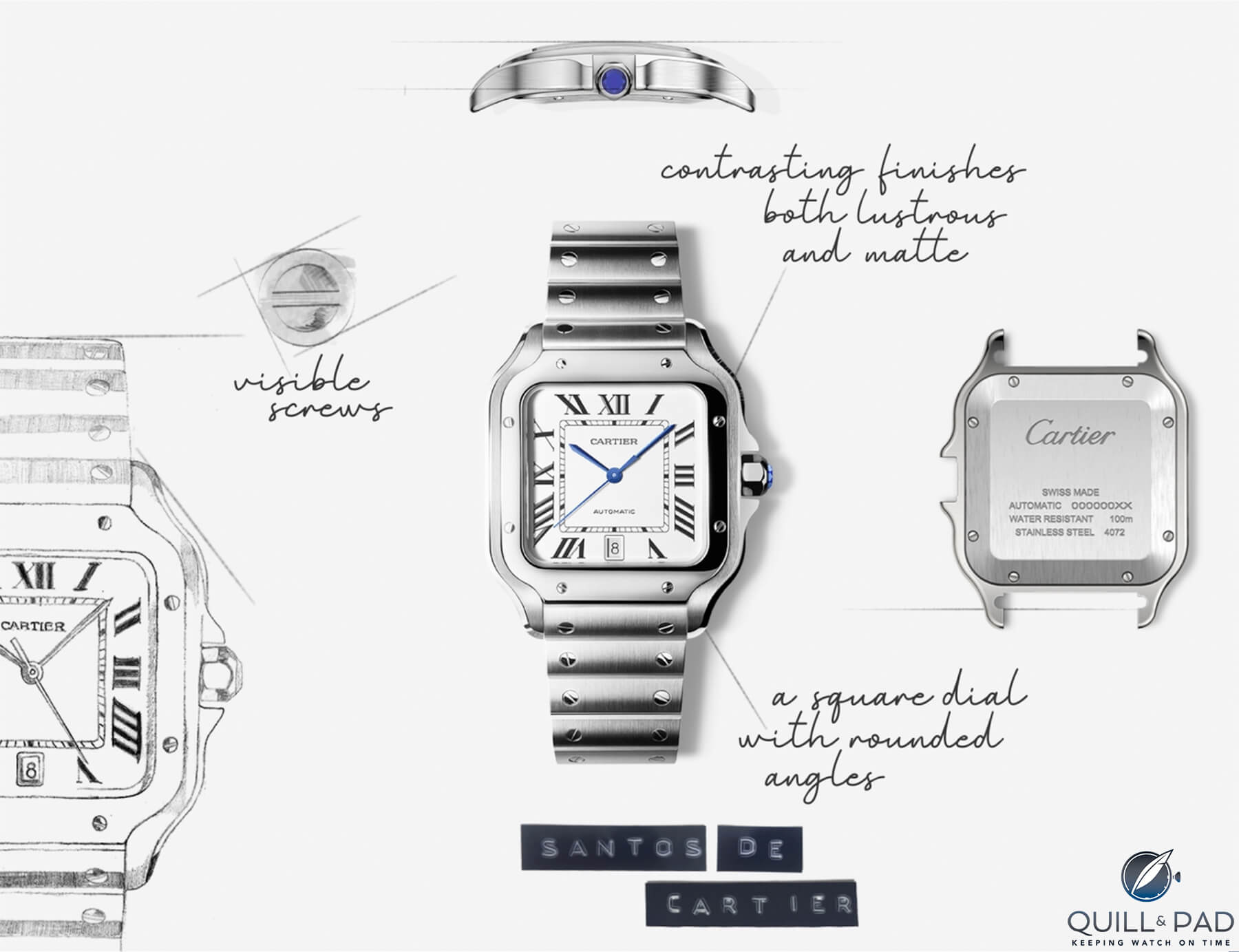
Cartier Santos
One of the best-known models is the Cartier Santos. Holding claim to being the first wristwatch for men ever produced, it remains the sporty staple of their collection. It feels as though there has been a renewed interest in Cartier and the Santos more specifically in recent years, but I still think there is room for this watch to be understood by more people. I say this because I am that person.
Previously, I appreciated the Santos from afar, but lately, something has clicked, and this watch has jumped up towards the top of my wish list. By sharing my impressions and feelings, I am hoping it may do the same for you.
Here I will look at the Santos de Cartier in-depth and look at how it has achieved such a standing in the watch community. Further, are there areas where I think there could be improvement?
It is not the most traditional sports watch, but should you consider it over others from Rolex and Omega? Santos de Cartier will be referred to as ‘Santos’ going forward for simplicity. There are other models such as the Santos Dumont, which is inspired by the original model, and the Santos Galbée, but if referenced it will be stated.
Brief History
The Cartier Santos has a very rich, long history; once understood, it helps you appreciate it beyond the timeless design. It began in 1904. Louis Cartier, the grandson of Louis-François Cartier, was managing the Cartier branch in Paris. One of his close friends was the Brazilian aviator Alberto Santos- Dumont. Born into a wealthy family of coffee producers, Santos-Dumont ended up dedicating himself to the early development of aircraft in Paris.

Alberto Santos- Dumont
Through his tests, Santos-Dumont was using a pocket watch which was less than ideal when checking timings. This inconvenience led him to meet with Louis Cartier, asking him to produce a wristwatch that would be more convenient. Cartier responded, designing a watch with a leather strap that could be worn on the wrist. No longer would Santos-Dumont have to take his hands off the yoke
The Santos was born. The pilot’s watch was born. The wristwatch for men was born.
The aesthetics were very much in line with what we know of the Santos today, as it was designed with a square bezel, a white dial, and Roman numerals. Santos-Dumont was very satisfied with the outcome and wore the watch on every test going forward. It was 1906, however, when the invention gained wider recognition. Aviation was of great interest at the time, and he became the first person to be filmed flying an aircraft.
Being widely known around Europe, the media attention Dumont generated led to people noticing what was strapped to his wrist.
————————————————————————————————————–
—————————————————————————————————-
Despite the intrigue generated by Santos-Dumont, a general sale release did not come immediately. This came five years later when Cartier collaborated with Edmond Jaeger, a movement maker at the time that later became part of Jaeger-LeCoultre. The watch was offered in a 25mm x 35mm platinum or gold case and was the first watch to feature a folding clasp. The societal landscape, let alone watches, changed due to the start of World War I, but despite shifts in focus and demand, the Cartier Santos survived.
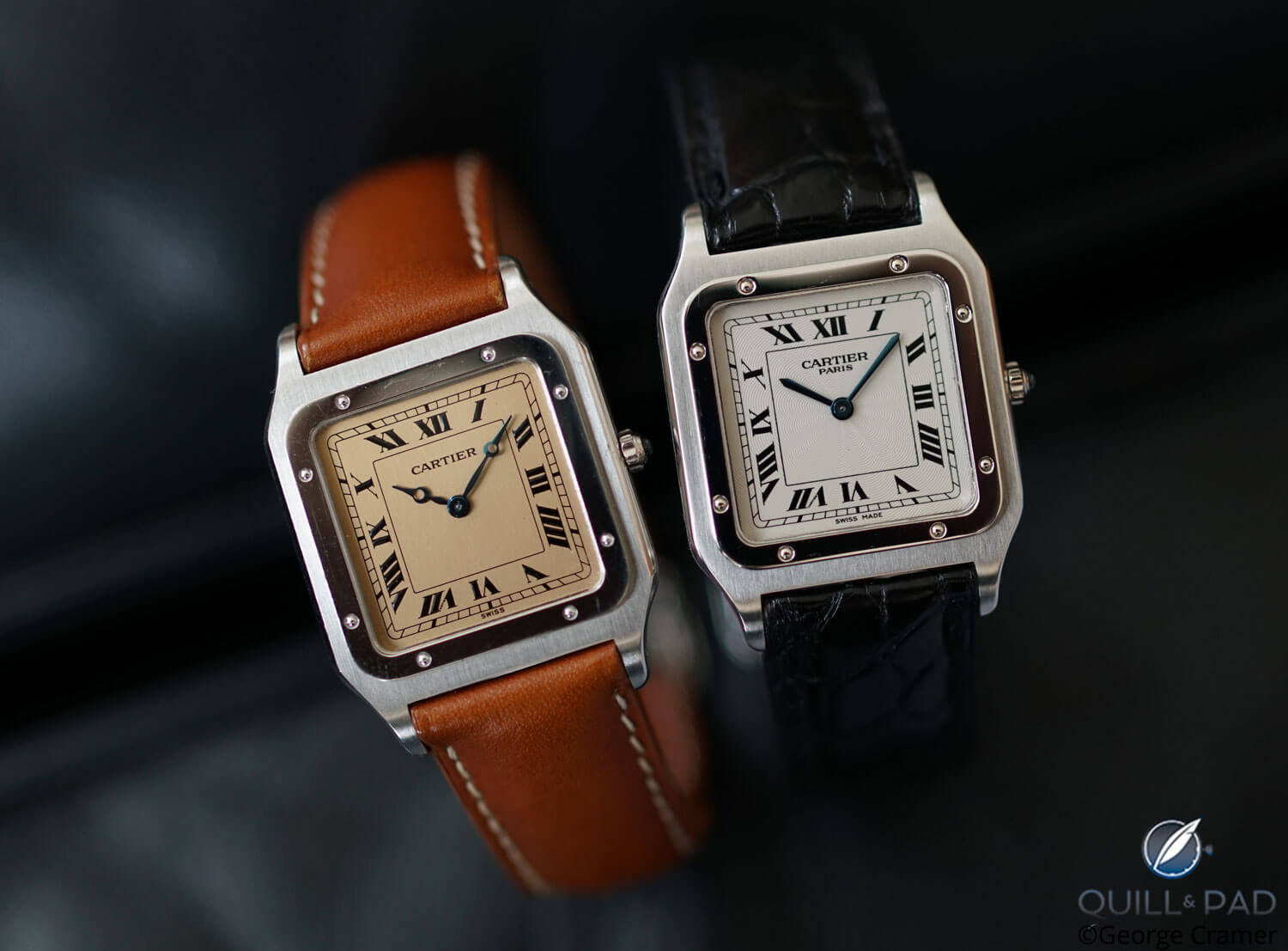
Cartier Santos-Dumont 90th anniversary (left) and Santos-Dumont Collection Privée Cartier Paris
Since this period, Cartier has produced countless references to the Santos, but the next big step forward came in the 1970s. This time was defined by two aspects: the Quartz Crisis and the emergence of luxury stainless steel sports watches, namely those designed by Gérald Genta. The latter was more relevant to Cartier. They noticed the trend of luxury watches being produced using stainless steel and an integrated bracelet.
To follow suit, Cartier rebranded the Santos as the Santos de Cartier. The update saw the Santos fitted with a bracelet, a bezel held in place with screws and offered in two-tone, followed by stainless steel shortly after. This saw the model evolve into what we know of it today. These changes came towards the end of the 1970s, but the popularity took off in the 1980s, especially for the two-tone model.
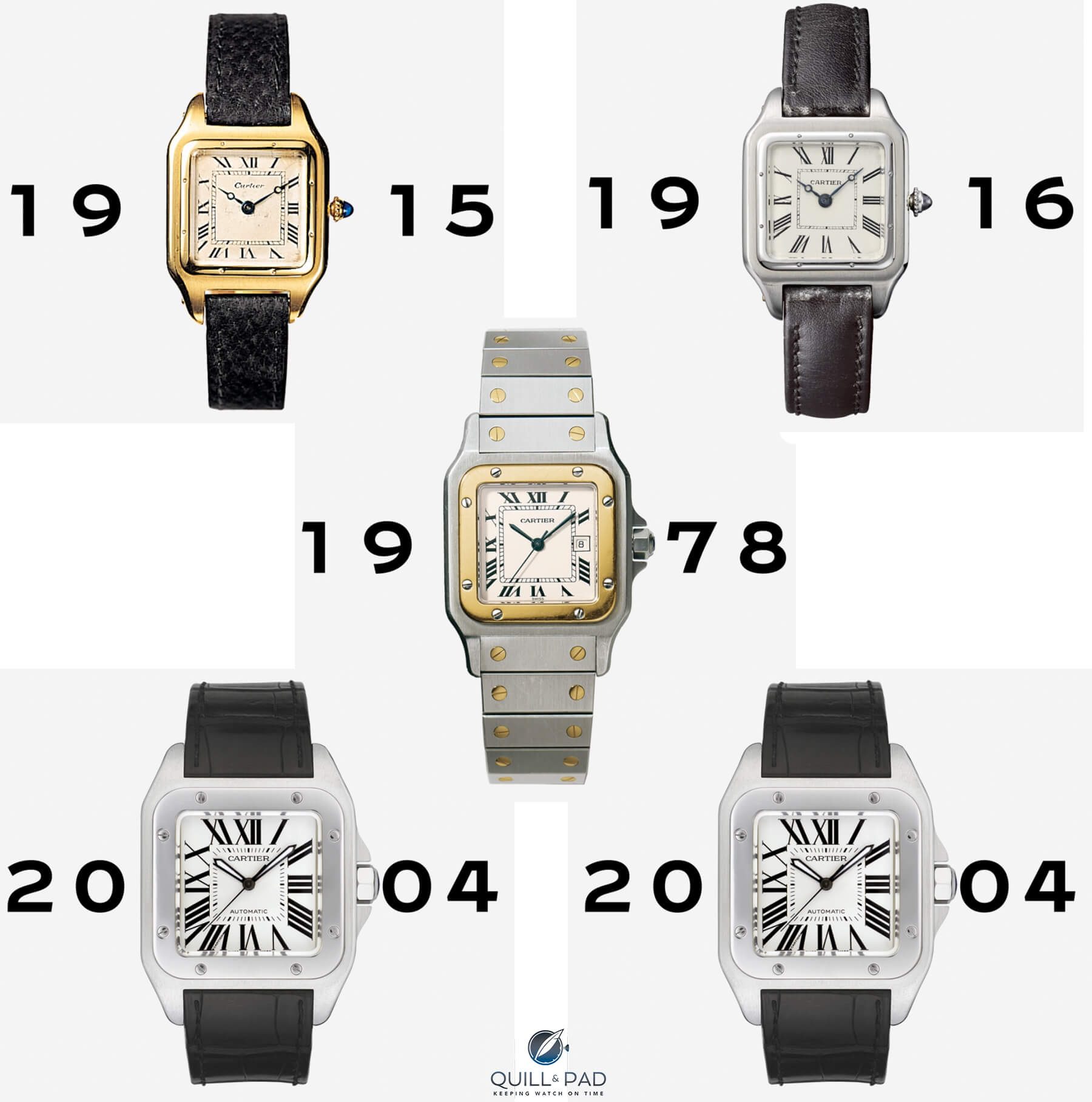
Evolution over more than a century of the Cartier Santos
The Modern Santos (2018 onwards)
Between the 1970s to the present day, there have been many references and variations, but the latest update came in 2018. Cartier replaced the outgoing Santos 100, initially launched in 2004, with a whole new collection. This included multiple sizes in stainless steel, two-tone and gold (rose and yellow), and skeleton dials. Since then, further references such as a chronograph, new dial colors such as blue and green, and ADLC/PVD bezels have been added.
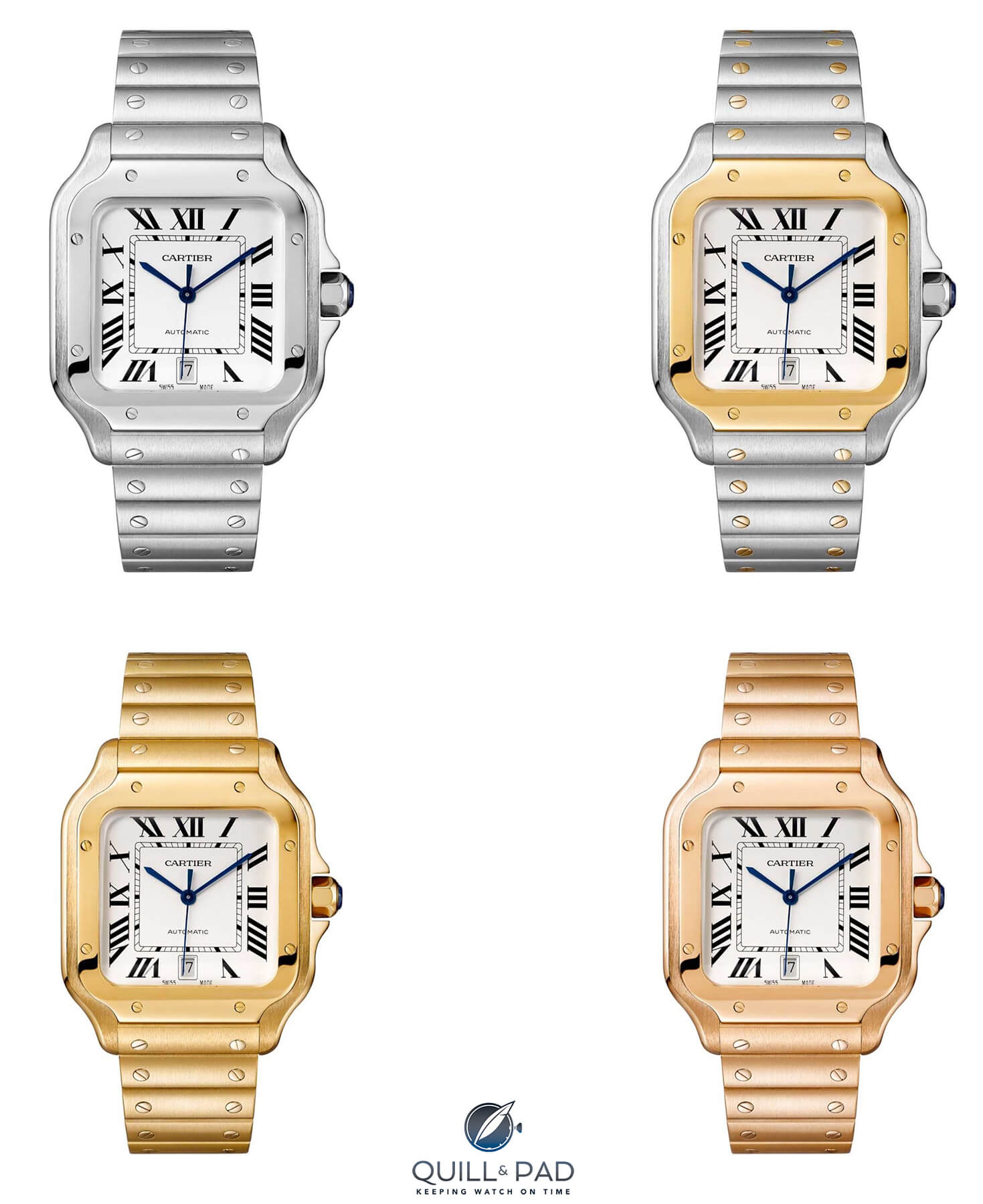
Cartier Santos case options
As you can tell, the Cartier Santos from 1904 does not change much in overall design barring the obvious, so producing a whole new collection within a confined framework is no easy feat. In my opinion, this new collection is a huge success, providing updates that take the watch back to its 1970s roots and making it more appealing to current watch trends.
Case
When discussing the Cartier Santos, you have to start with the case. The updated collection is offered in medium and large sizes, followed by an extra-large for two chronograph references. It is difficult to talk sizes in the traditional sense when looking at square watches, but for those looking for specs, the medium case is 35.1mm x 41.9mm and the large is 39.8mm x 47.5mm. Both are also thin watches with the thickness coming in at 8.83mm for the medium and 9.08mm for the large.
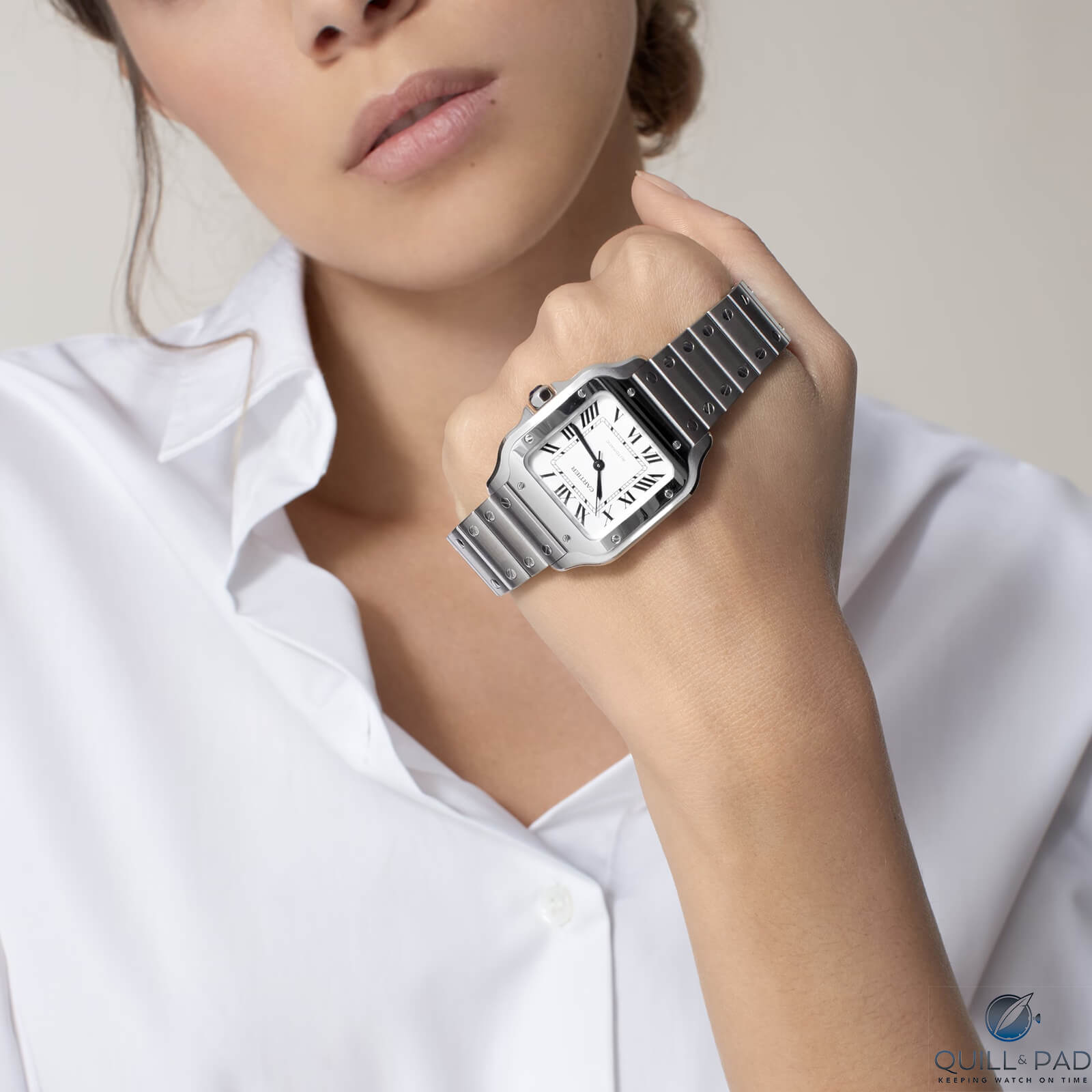
Cartier Santos medium
What does this mean? I am sure you may think a 35.1mm case diameter might be small, although when they are on your wrist, they will feel larger. I couldn’t put an exact number on it, but the medium wears as if it were a 36-37mm watch. The same relative increase can be applied to the large. The reality is there needs to be a new measurement for square watches to make it easier to understand wrist presence from a spec sheet, but I will leave that to someone out there to devise.
—————————————————————————————————–
—————————————————————————————————–
It is worth mentioning that the Santos has 100m water resistance, without a screw-down crown, helping it achieve a sports watch status and bringing it in line with the competition such as the Rolex Datejust.
The Santos is a square watch, however, with the latest update this has been toned down and Cartier added extra curvature. The first area to notice this is the case shape itself. The lugs now are further accentuated, providing a flowing look that seamlessly transitions into the bracelet. The crown guards have also been redesigned. Where on the Santos 100 (the previous iteration) they were straighter, leading out from the case, the new collection has shorter crown guards with a more pronounced wave that blends perfectly into the case.
If they were to stop here, the watch would have a more elegant feeling, but Cartier went further.
The bezel itself used to be an undeniable square, further underscoring the shape of the watch. However, Cartier decided to change this, and the bezel now extends down into the lugs. These changes together bring a whole new aesthetic, giving the watch a softer, more integrated appearance. The bezel has a polished finish, which looks great but is undeniably a scratch magnet – we will return to this point later. The rest of the case has a mix of polished and brushed surfaces, adding a sense of depth.
The top of the case just below the bezel is brushed, creating the impression the dial is very much encased and gives the watch a solid feel. Overall, the changes bring a new aesthetic to the watch, transforming it from a square design to an integrated design.
The final point to highlight, although this is not new to the current collection, is the case has a slight curve when viewing the side profile. It keeps the watch from sitting flat on your wrist, makes it look more unified with the bracelet and ultimately, brings extra comfort. This curve is found on the sapphire crystal as well, creating a pleasing distortion to the dial at an angle.
Bracelet
The bracelet may have only been introduced in the 1970s but has since become synonymous with the Cartier Santos and for good reason. The bracelet, in my eyes, makes this watch what it is. The links are straight and add to the angular look of the Santos, yet each link is slightly domed making it supple to touch. This aspect creates some visual interest with how it interacts with light despite being fully brushed on the surface.
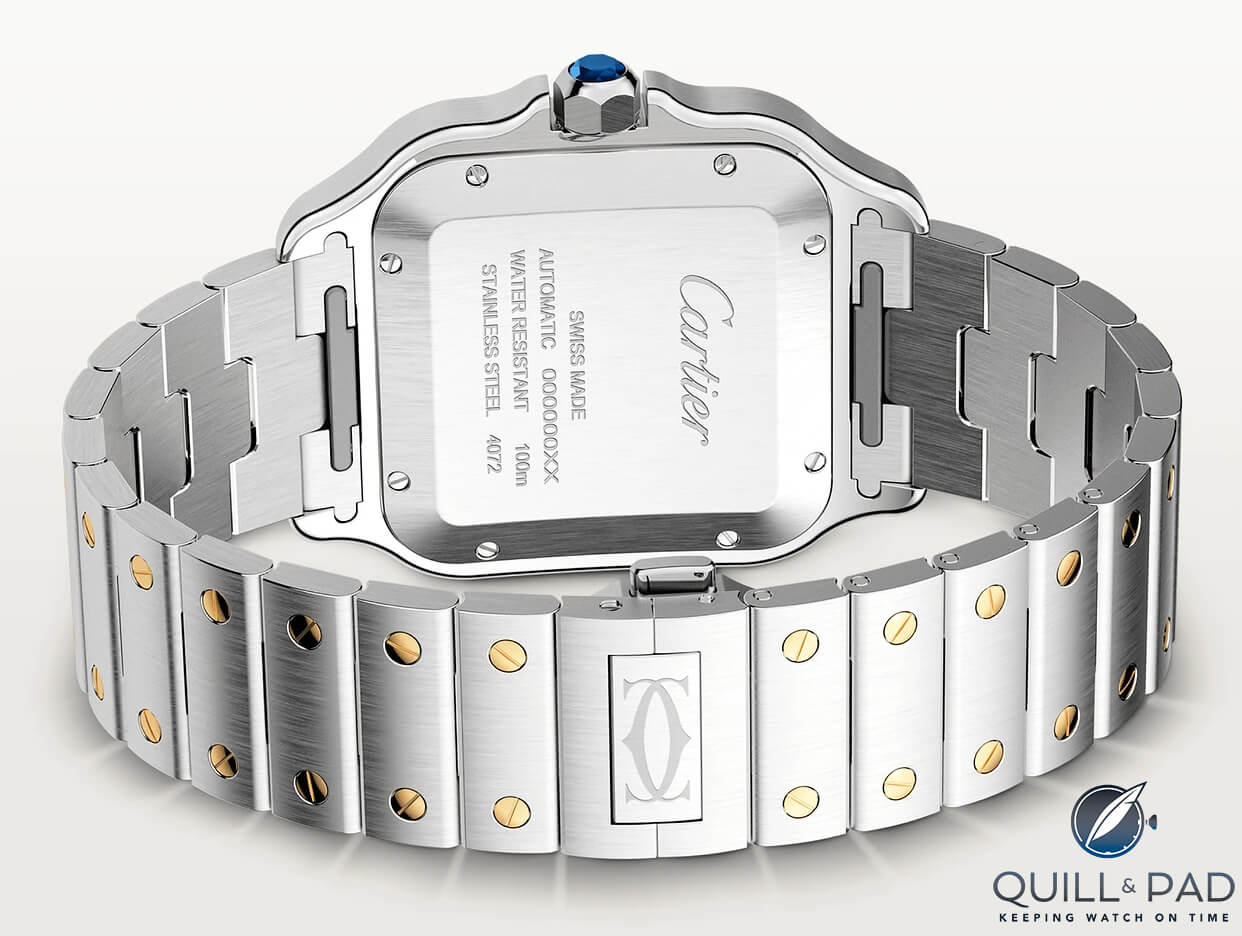
Solid caseback and bracelet of the Cartier Santos
Then there are the screws found on every link. The screws are a defining characteristic of Cartier and draw on their jewelry design language. Each is polished and for the two-tone model, the screws are gold, set into the stainless steel link.
This is a unique take on how to execute a two-tone watch. To point out the obvious, the screws are not aligned (like the bezel) and while this can initially seem like an oversight or an annoyance, it has grown on me. By being disordered, it contrasts the rigidity and straightness of the rest of the watch. Finally, the bracelet has a nice taper from the case down to the butterfly clasp.
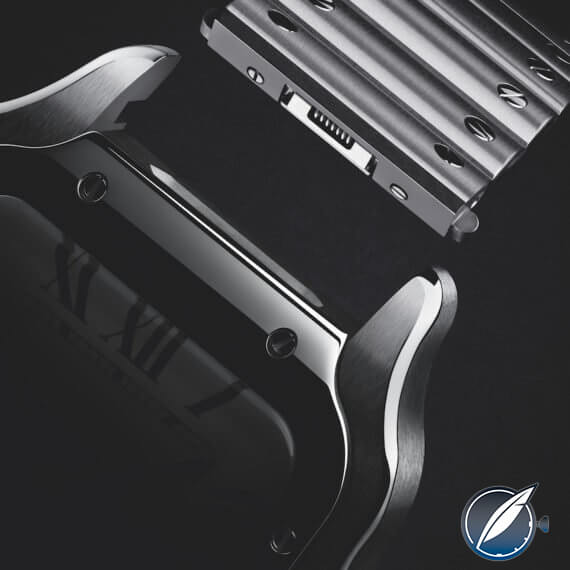
Cartier Santos 2018 quick release lug-bracelet
—————————————————————————————————–
—————————————————————————————————–
Everything I have mentioned so far is very similar to the bracelets found on the Santos in the past. Where things get interesting for the latest iteration is the technology Cartier has incorporated into the bracelet. Cartier developed the SmartLink and QuickSwitch systems, making the bracelet one of the most user-friendly on the market.
SmartLink allows you to adjust the bracelet length without using any tools. There are small buttons on each link that can be pressed with almost anything (bear in mind if you use something sharp, you may scratch the bracelet), which releases the pin, allowing you to remove the link. Cartier developed the system so that the pin does not come all the way out, so there is also no concern about losing anything.
The bracelet might not have a micro-adjustment, but it could not be easier to add links when the weather gets warmer. The QuickSwitch system is a similar concept. When you want to change the strap, there is a button found between the lugs that can be pushed to release the bracelet. A leather or rubber strap can be then clicked into place. Again, this is all achieved without using any tools and can be done in a matter of seconds.
Seeing and experiencing a bracelet/strap such as this makes you wonder why all brands are not developing similar systems. I cannot speak highly enough of what Cartier has achieved here.
Dial
The dial looks very similar to previous Santos models and that’s no bad thing. There is still an Art Deco vibe providing the watch with an abundance of elegance. I will focus on the traditional white dial to break down the different details to look for, although there will be slight differences with the colored dials.
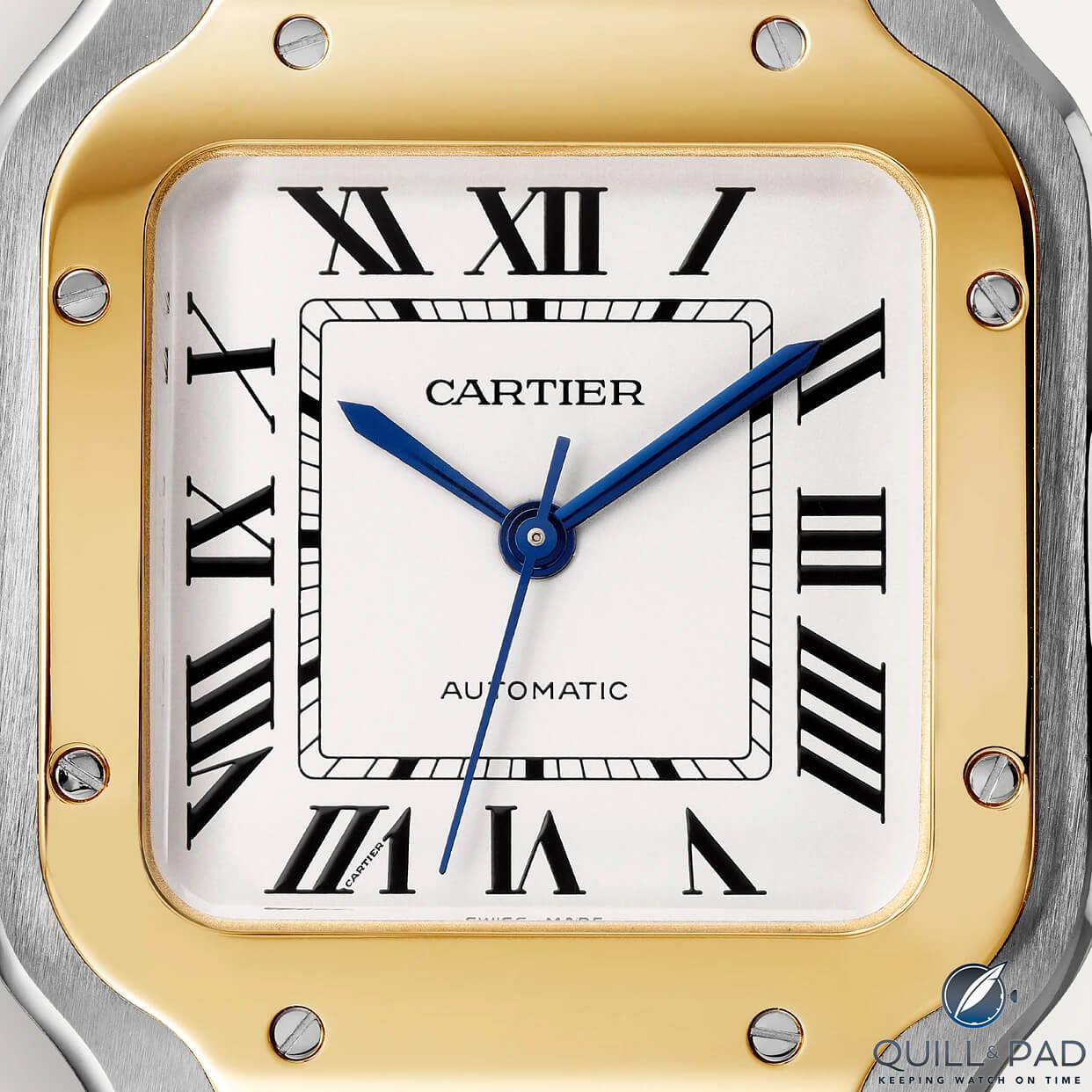
Cartier Santos two-tone dial
At first glance, it looks relatively straightforward. A white dial with black Roman numerals. Look closer, however, and you realize the dial reflects what we see with the rest of the watch. The dial printing is a deep black that almost looks inky and, even though it is printed, the indices are raised. Not by much, but it is there and can be seen under the light.
There is the famous Cartier stamp intertwined at the 7 o’clock index, although this is not found on the darker dial options. Moving inwards, you find the minute track on the inside of the hour indices. Interestingly, the minute hand extends beyond the minute track so setting the watch accurately can be slightly tricky. This might not be practical, but it balances the dial well and looks good in the process.
What is it like to wear?
A watch can look great and have all the heritage you could ask for but if you put it on your wrist and it doesn’t feel good, it can be underwhelming. I have experienced this many times: I get excited about something yet once it is on the wrist then I feel let down that it doesn’t sit right. I have even sold watches for this reason. I am pleased to report, the Cartier Santos might be the most comfortable watch I have ever worn.
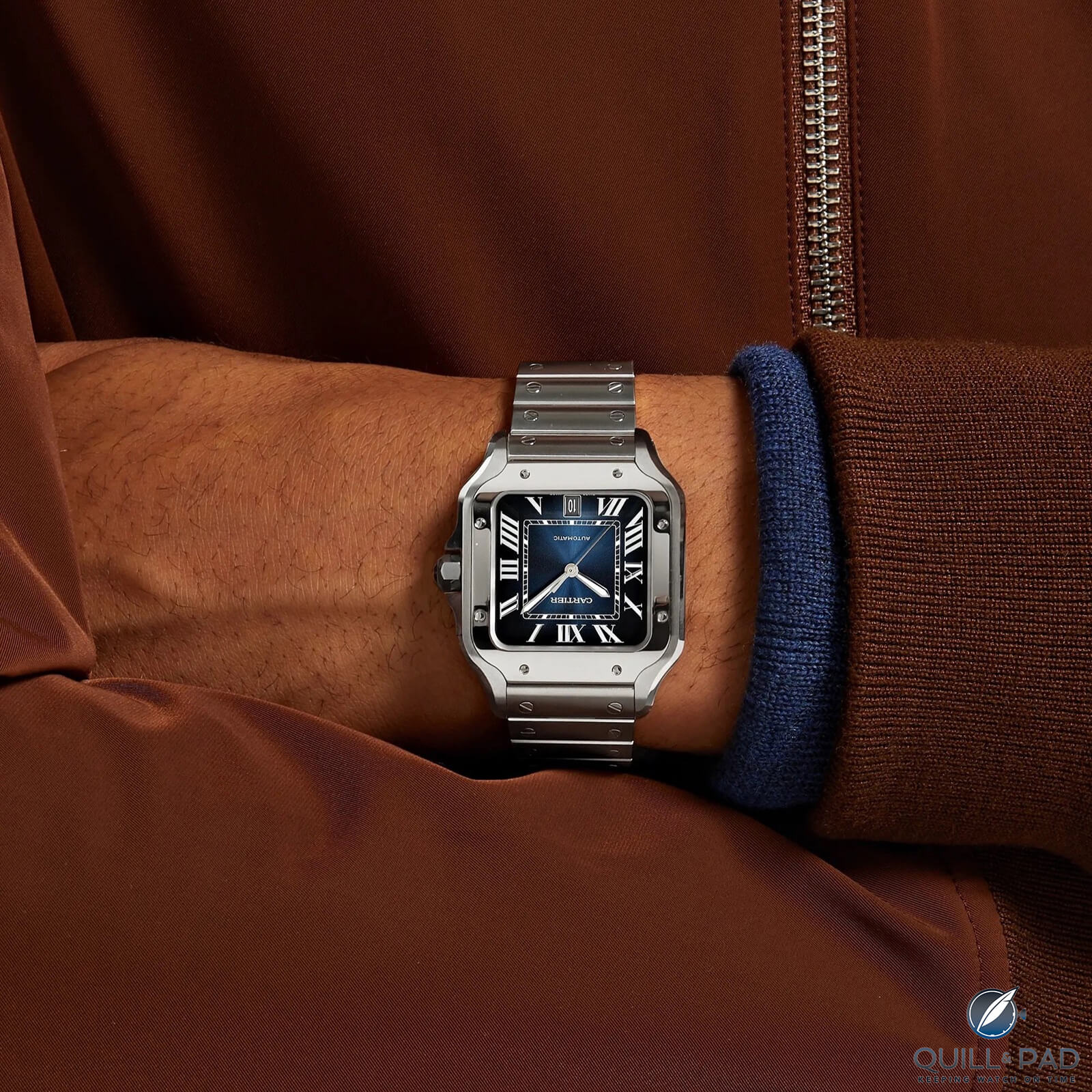
Cartier Santos on the wrist
—————————————————————————————————–
—————————————————————————————————–
Obviously, sizing will make a difference and I want to highlight again that the Santos is available in various size options so one will likely fit you. What you will find is the bracelet has a sense of solidity. There are barely any gaps between the links and the finishing is such that it felt like a leather band. The case sits thin atop your wrist and the curvature of the case makes it feel as though it was one with the bracelet. Clearly, Cartier has experience in jewelry, and maybe it could be a factor in why the bracelet feels so good. The only other bracelets I have experienced that are in the same category are those from Rolex.
Then there is the feeling once you have it on. Some watches are truly iconic, and the Cartier Santos is one of them. This is now subjective and how I felt when I first experienced the Rolex Submariner. There is a sense of occasion with the Cartier Santos. You can’t help but feel something inside, regardless of whether the watch ends up working for you.
It has such a status, history, and notable design that you end up having to acknowledge it. Other watches have made me feel this way and I can say not all of them I like or suit my style, yet as a watch enthusiast, there is a level of appreciation. Once this initial reaction faded, the watch disappeared in a good way. It fell under my cuff and given the bracelet comfort, it just sat on my wrist seamlessly waiting for me to notice it again. I did not get much time with the watch, but it felt like I had owned it for years.
Improvements
No watch is perfect, and I will keep saying this. Some come very close, but there is always room for improvement and the Cartier Santos is no different. In my opinion, this improvement can come in two main areas: the movement and the bezel.
1. Movement
Up to this point, you may have wondered why there has been no mention of the movement found in the Cartier Santos. Cartier uses the 1847 MC caliber that they first launched in 2015. It has a non-magnetic in-house movement with a 42-hour power reserve, a solid 4Hz frequency and an accuracy of -3/+7 seconds per day. The finishing is minimal but with a solid caseback, you won’t notice this. There is nothing wrong with this movement, but there is also nothing special about it.
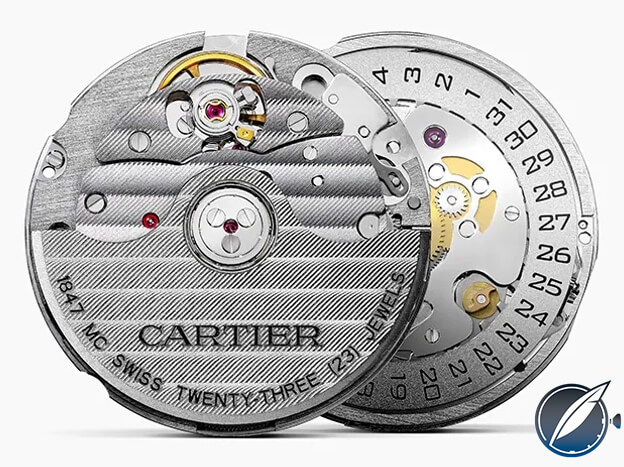
Cartier manufacture Caliber 1847 MC automatic winding
Day-to-day will it change your experience of owning this watch? Not really, although with prices moving higher and several brands pushing ahead with movement capabilities, the 1847 MC could be better. Look at examples from lower-priced brands like Oris and Tudor but even direct competitors such as Rolex, Omega, and Zenith. I understand there is more to a watch than the movement, but as Cartier moves the price upwards (along with the rest of the industry), there is a bit more to be desired.
2. Bezel
I am going to say this upfront; I love the Cartier Santos bezel. The improvement compared to the Santos 100 is probably the main factor as to why my feelings towards the watch have changed. However, it is a scratch magnet. This might not be a problem for you, but it does create mixed emotions as some prefer to keep their watches pristine. I would add here just as a consideration, the scratches could be viewed as a type of patina – the watch evolves with you – but I know that won’t change things for the majority.
—————————————————————————————————–
—————————————————————————————————–
Since 2018, there have been a few references that feature ADLC and PVD, coming with a brushed finish so there are alternative options if you are concerned by the wear and tear. These options though are limited to the large cases only. What I would like to see is something similar on a medium model.
Moreover, I want to see Cartier go all the way and offer a brushed stainless steel or gold bezel. I feel as though it could build on the sports watch aspect of it. Combine this with some beveled edges and the watch will look even more integrated with the bracelet. If this became a reality, it would be my pick in a medium size.
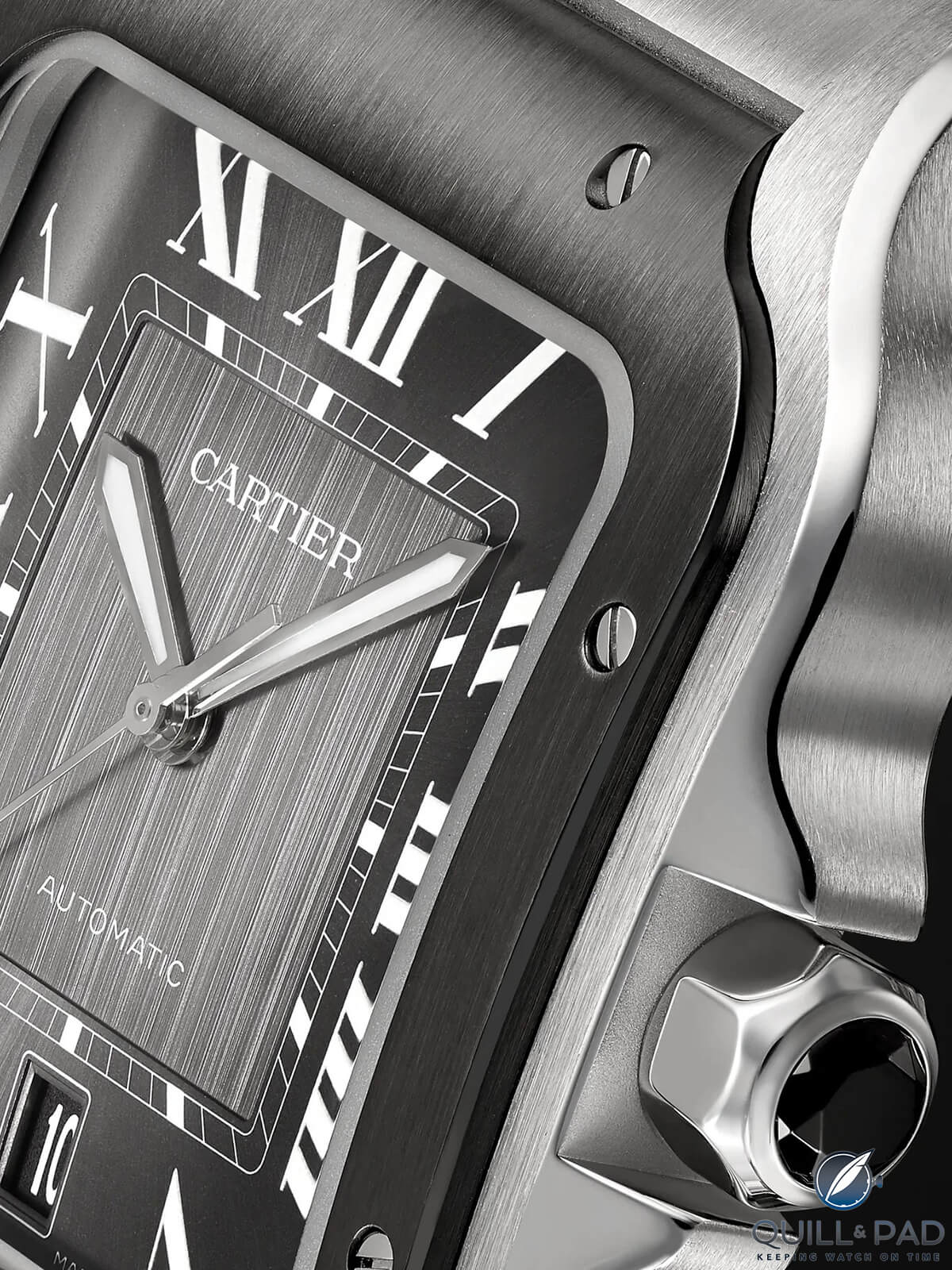
Cartier Santos dial details
Why go for a Santos over a Rolex or Omega?
Should you consider a Cartier Santos for your collection? I think so. It is hard not to have preconceptions of such an iconic watch, however, whatever they may be, I would urge you to go and experience one at an AD. It might change your mind, especially with the updates compared to the prior Santos 100.
The biggest question is whether you should be considering the Santos over other sports watches in the same price range from Rolex and Omega. The specs of this watch mean it can compete with sports watches and it is technically defined as that. Before directly answering the question though, I want to spell out what you do get by going for the Santos.
The Cartier Santos was the first wristwatch made for men and the first pilot’s watch. Heritage is abundant. Then we move to the design which has stood the test of time. On the one hand, this watch is extremely elegant; on the other, it has an industrial look with exposed screws and bezel. The Santos is extremely versatile whether you wear it on a bracelet, leather, or rubber strap.
From an informal standpoint, with this new collection, the changes to the bezel soften the sharp edges and lead to that integrated look. The industry and consumers are obsessed with integrated sports watches for the last few years, yet no one brings up the Cartier Santos in that conversation.
Is this potentially an integrated sports watch with an original design that is being overlooked? I think it might be. It is squarer than the watches that are receiving all the hype, but when you look at options such as the Zenith Defy or Chopard Alpine Eagle, which are new designs, you have to ask yourself whether you want a watch that resembles the obvious (Audemars Piguet Royal Oak) or one that has a similar feel yet is unique in its own right.
Then, when you need something more formal, you can still wear the Cartier Santos. The Art Deco dial and seven-sided crown set with a synthetic spinel give it a sense of occasion. The curved case with polished and brushed finishes feels as though the watch is built into a piece of jewelry. It gives the impression that this could be considered an extension of the Cartier Love bracelet range, and looking at the prices of those, it makes the Santos seem like good value!
—————————————————————————————————–
—————————————————————————————————-Considering this, I am going to ask a question that might be bold, but I want to anyway just to get you thinking from a different angle. You can disagree, and as of now, I don’t know where I stand on this. Given just how elegant the Santos can be, rather than being compared to the Rolex Datejust, should it be viewed in a similar vein to the Rolex Day-Date?
The Day-Date is arguably the most refined-looking Rolex with the President bracelet and the dressiest Rolex outside of the new Perpetual 1908. The Datejust, especially those on the Oyster bracelet with a smooth bezel, is skewed towards the sports watch angle. I know the Day-Date has a complication and there are differences in material options and prices, but in terms of elegance, does the Santos align closer to the Day-Date?
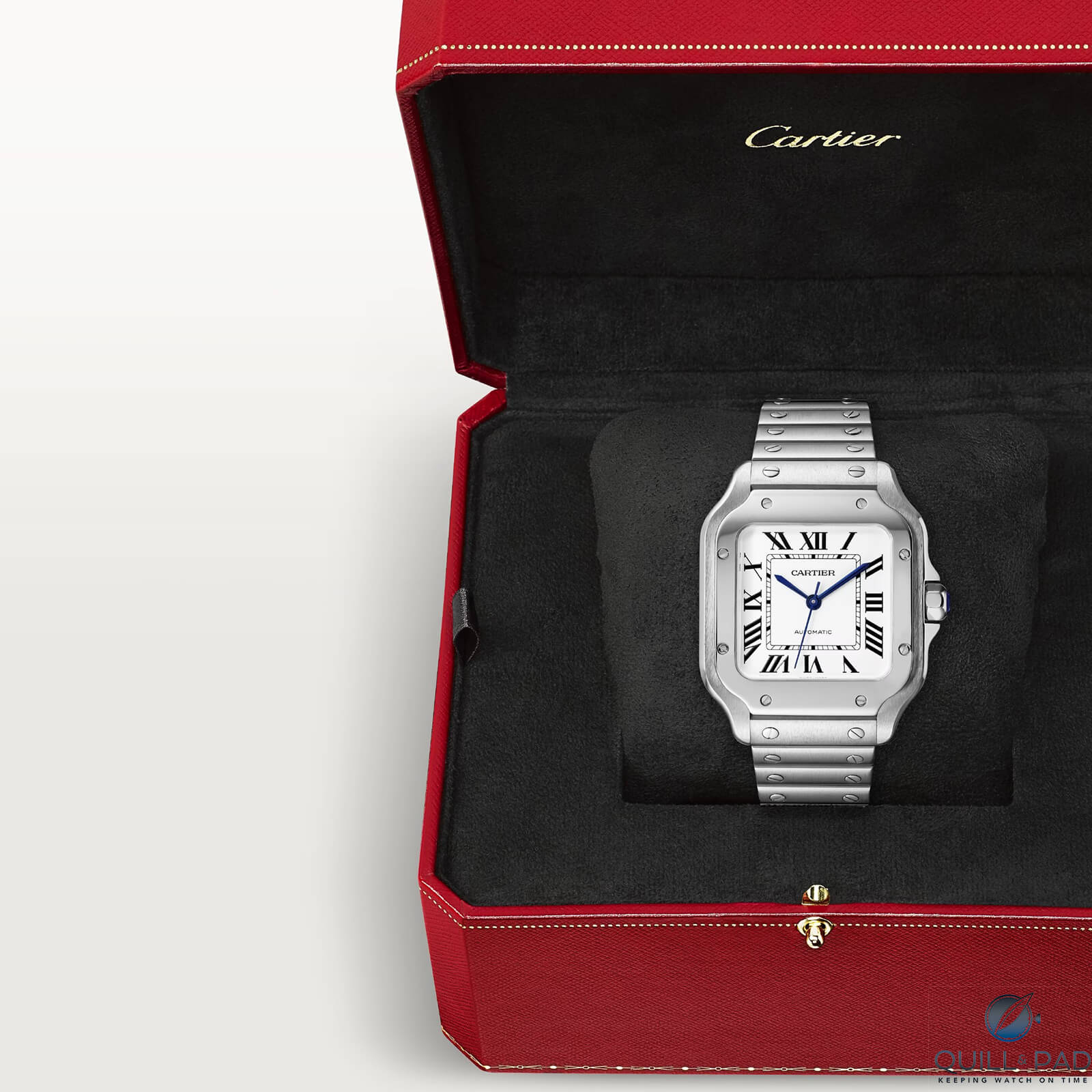
Cartier Santos in box
Regardless of your answer, the Cartier Santos could be a one-watch collection, especially for those who don’t require a watch for outdoor activity beyond jumping into a pool. If you are going between work, dinners, shopping, and events (there may be other activities of course), this could be seen as the thinking-persons sports watch given its ability to adapt so effortlessly.
So back to the original question, is it worth considering? Yes. Is it worth considering over comparisons such as the Rolex Datejust or Omega Aqua Terra? I certainly believe so. You need to decide whether the aesthetic is for you, but the Santos can certainly hold its own against these two heavyweights.
Conclusion
The Cartier Santos has a long, rich history and ever since its initial public release in 1911, the design has remained intact. It has always been considered a more formal, square watch; however, with the latest update to the collection in 2018 that has started to shift. No longer do we find such sharp lines on the case. Cartier added curvature to the lugs and crown guards, but most notably the bezel has been softened. It now blends into the lugs and flows more seamlessly into the bracelet providing it with an integrated aesthetic, aligning the Santos to broader watch trends.
In doing so, it retains and builds upon its ability to balance elegance and sportiness, adding to its overall versatility. The specs back this up with 100m water resistance, QuickSwitch and SmartLink systems on the bracelet and attractive dimensions, particularly the thickness (or rather, thinness). As always, there is room for improvement going forward, but as it stands today, this could be the thinking-persons sports watch. Annoyingly for me, I liked it more than I ever imagined I would, and it has now ended up on my ever-growing wish list.
For more information, please visit www.cartier.com/en-us/watches/collections/santos-de-cartier/
Quick facts: Cartier Santos Medium
Indications: hours, minutes and seconds
Case: stainless steel
Size: 35.1mm width x 8.33 high
Movement: Manufacture caliber 1847 MC, automatic winding
Water resistance: 100 meters
Bracelet: Steel bracelet with “SmartLink” adjustment system. Second bracelet in calfskin, with interchangeable steel folding buckle. Both bracelets are fitted with the “QuickSwitch” interchangeability system.
Price: USD $7050
You can read more articles by Raman Kalra at www.thewatchmuse.com.
You might also enjoy:
The World‘s First Pilot’s Watch: Cartier Santos-Dumont 1904 To 2018
Cartier Rotonde De Cartier Masse Mystérieuse: Its Ingenious Gearing Is Simply Magical
What’s It Like To Get Your Grail Watch And Live With It? The Story Of My Louis Cartier Tank
The Best-Looking Cartier Santos-Dumont Is Also The Most Affordable
Leave a Reply
Want to join the discussion?Feel free to contribute!

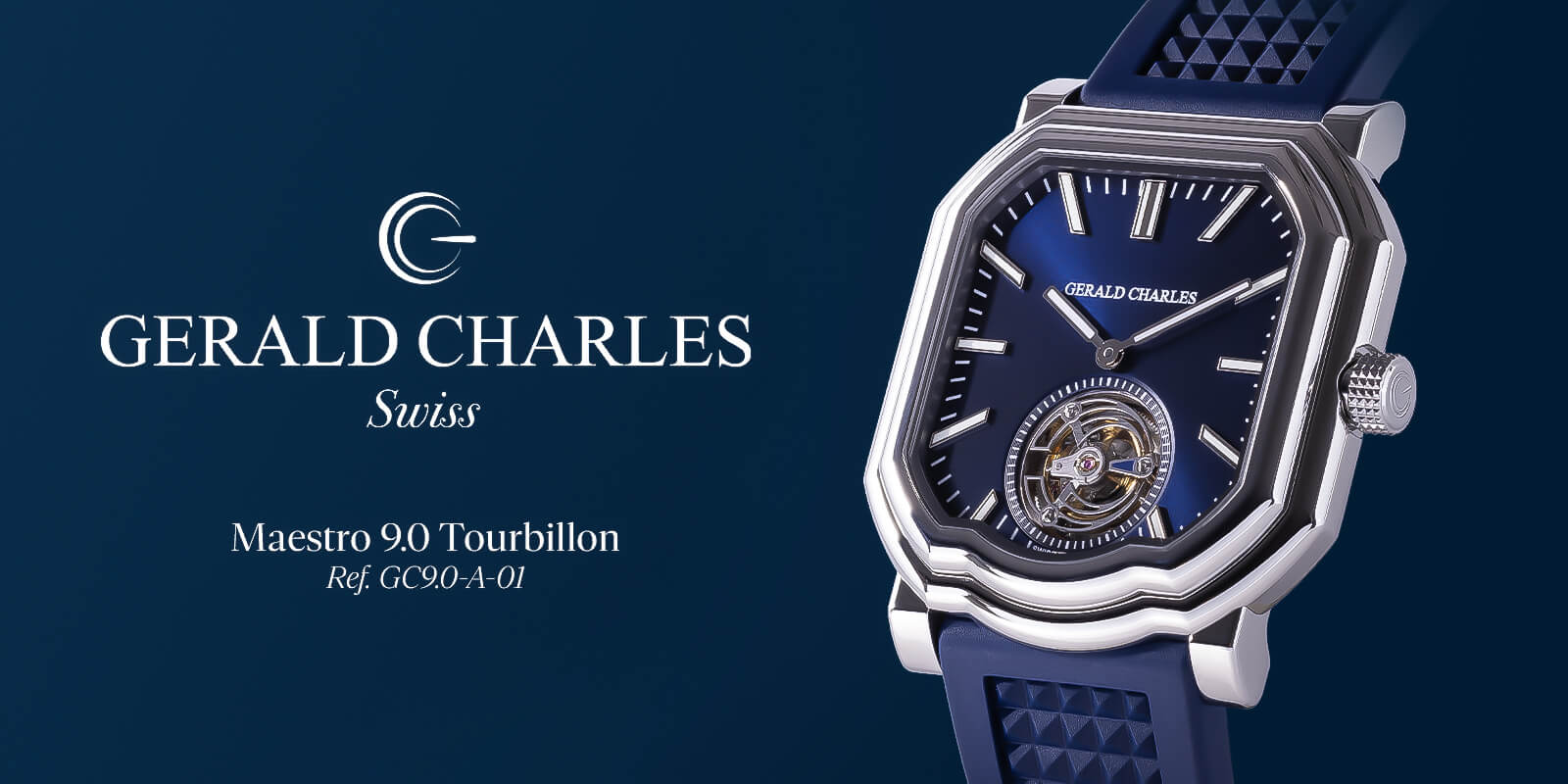
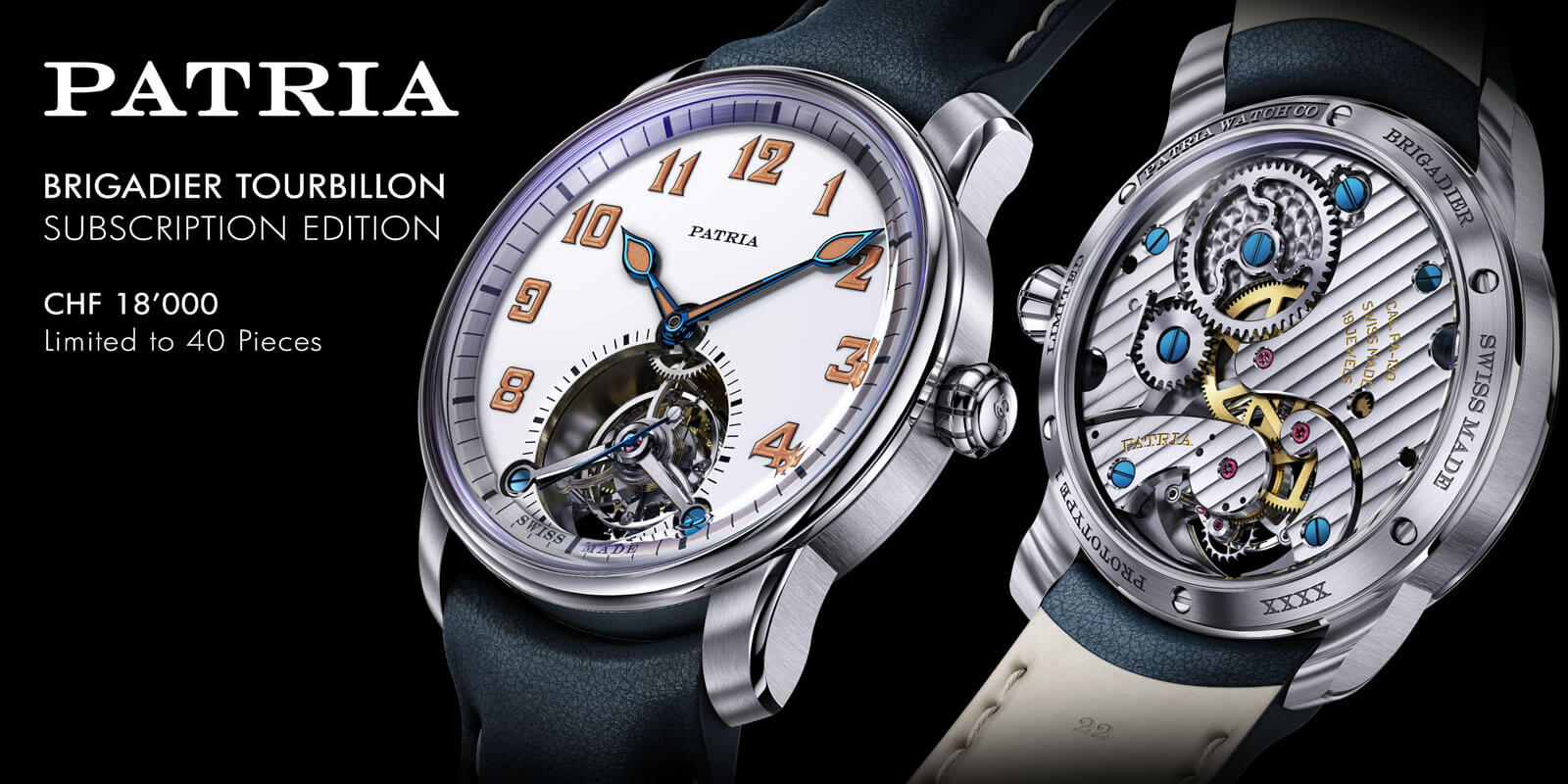
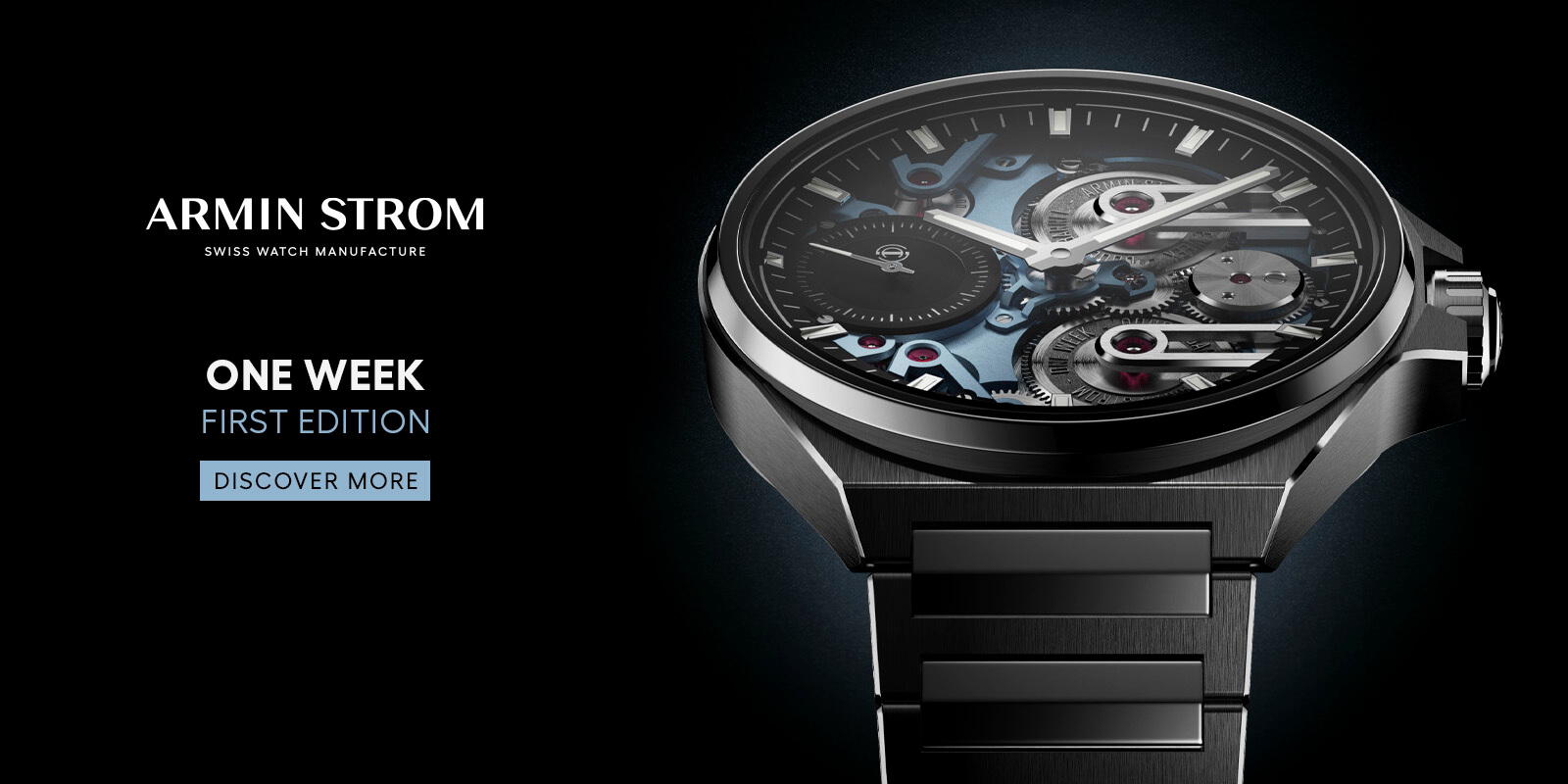


I agree. Would love to see a brushed stainless steel/gold for the bezel. It would give it a vintage look too which could be cool. Plus, in comparison with the Rolex I would take the Santos over the Rolex any day. I’m not a fan of Rolex watches. They are cliche to me.
Happy you agree on the bezel Glenn! At least I am not the only one 🙂
❤️…love it.
Exclusive-Classy.
Thank you Cartier.
Really enjoyed the detailed comparison in this post